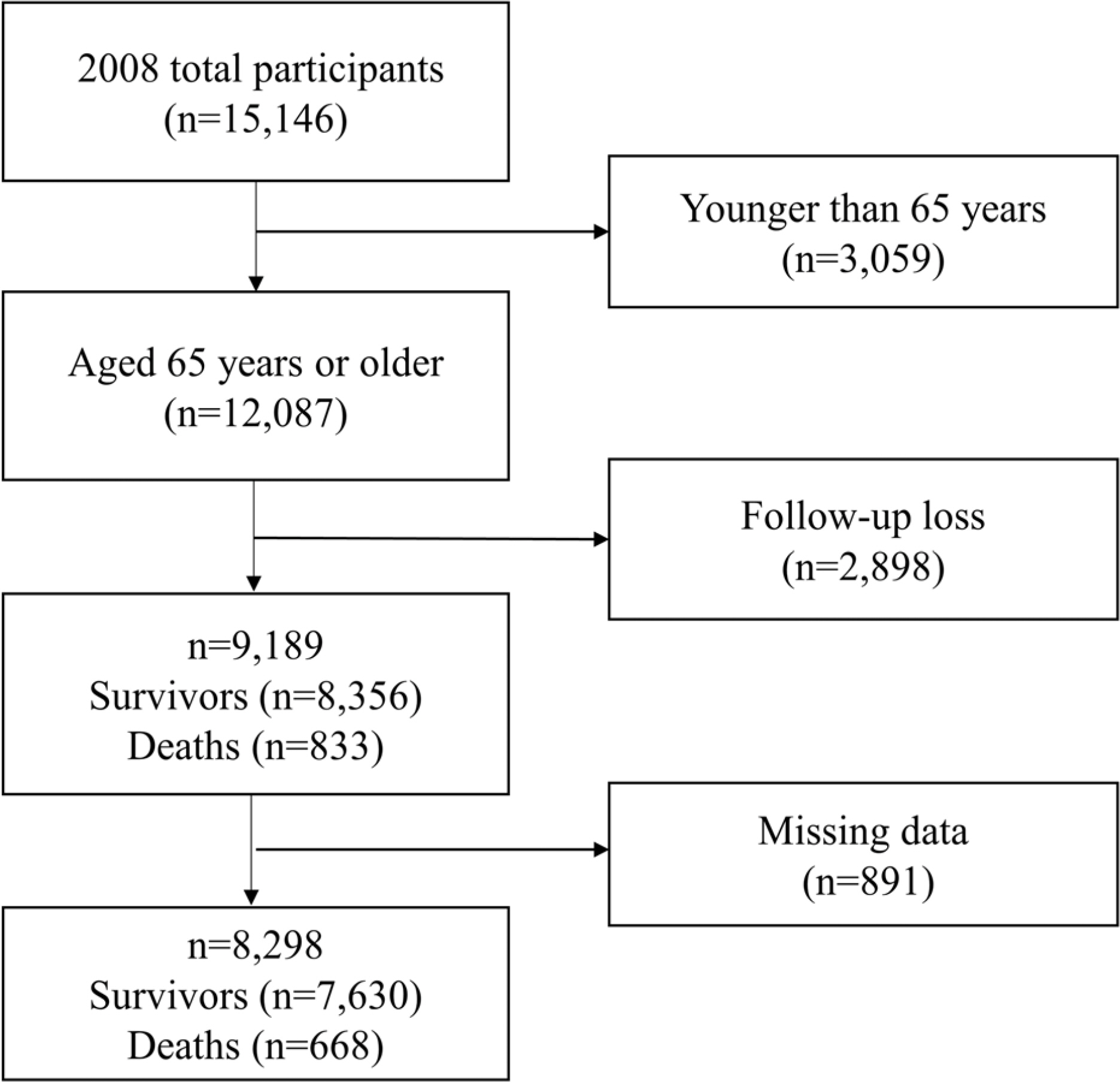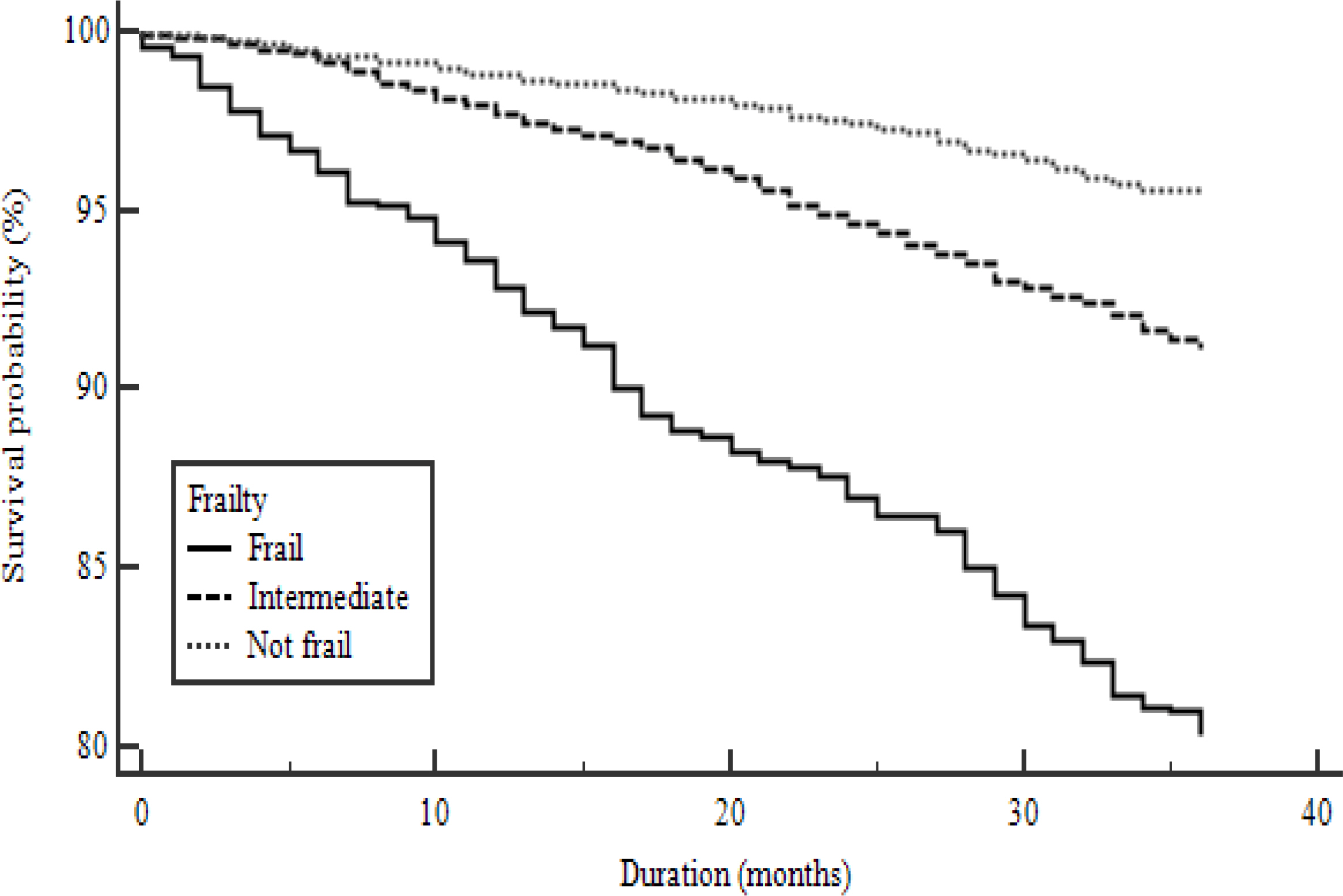1PhD Candidate, College of Nursing, Hanyang University, Seoul
2Professor, College of Nursing, Hanyang University, Seoul, Korea
Copyright © 2017 Korean Society of Adult Nursing
This is an Open Access article distributed under the terms of the Creative Commons Attribution Non-Commercial License (http://creativecommons.org/licenses/by-nc/3.0) which permits unrestricted non-commercial use, distribution, and reproduction in any medium, provided the original work is properly cited.




Characteristics of Participants at Baseline 2008 (N=8,298)
| Variables | Categories | Total (n=8,298) | Survivors (n=7,630, 91.9%) | The deceased (n=668, 8.1%) | x2 | p |
|---|---|---|---|---|---|---|
| n (%) or M±SD | n (%) or M±SD | n (%) or M±SD | ||||
| Gender | Female | 4,840 (58.3) | 4,550 (59.6) | 290 (43.4) | 66.48 | <.001 |
| Male | 3,458 (41.7) | 3,080 (40.4) | 378 (56.6) | |||
| Age (year) | 65~74 | 5,417 (65.3) | 5,147 (67.5) | 270 (40.4) | 198.12 | <.001 |
| ≥75 | 2,881 (34.7) | 2,483 (32.5) | 398 (59.6) | |||
| 72.97±5.83 | 72.62±5.57 | 76.99±7.08 | ||||
| Educational level | No education | 3,014 (36.3) | 2,717 (35.6) | 297 (44.5) | 20.91 | <.001 |
| Elementary school | 3,135 (37.8) | 2,918 (38.2) | 217 (32.5) | |||
| ≥Junior high school | 2,149 (25.9) | 1,995 (26.2) | 154 (23.0) | |||
| Cognitive impairment | Yes | 2,049 (24.7) | 1,811 (23.7) | 238 (35.6) | 46.72 | <.001 |
| No | 6,249 (75.3) | 5,819 (76.3) | 430 (64.4) | |||
| Limitation in IADLs | Yes | 2,073 (25.0) | 1,764 (23.1) | 309 (46.3) | 175.47 | <.001 |
| No | 6,225 (75.0) | 5,866 (76.9) | 359 (53.7) | |||
| Urinary incontinence | Yes | 136 (1.6) | 125 (1.6) | 11 (1.6) | 0.01 | .987 |
| No | 8,162 (98.4) | 7,505 (98.4) | 657 (98.4) | |||
| Number of falls in the past year (range: 0~10) | 0 | 6,941 (83.6) | 6,402 (83.9) | 539 (80.7) | 16.75 | <.001 |
| 1~2 | 1,039 (12.5) | 955 (12.5) | 84 (12.6) | |||
| ≥3 | 318 (3.9) | 273 (3.6) | 45 (6.7) | |||
| 2.13±1.99 | 2.07±1.93 | 2.68±2.48 | ||||
| Depressive symptoms (range: 0~15) | Yes | 2,498 (30.1) | 2,204 (28.9) | 294 (44.0) | 66.79 | <.001 |
| No | 5,800 (69.9) | 5,426 (71.1) | 374 (56.0) | |||
| 5.26±4.52 | 5.10±4.47 | 7.04±4.66 | ||||
| Frailty | Not frail | 3,331 (40.1) | 3,181 (41.7) | 150 (22.5) | 191.58 | <.001 |
| Intermediate | 4,251 (51.2) | 3,874 (50.8) | 377 (56.4) | |||
| Frail | 716 (8.7) | 575 (7.5) | 141 (21.1) |
IADLs=instrumental activities of daily living.
Risk Factors of Mortality among Older Adults in Korea (N=8,298)
| Variables | Model 1 | Model 2 | Model 3 | |||
|---|---|---|---|---|---|---|
| HR (95% CI) | p | HR (95% CI) | p | HR (95% CI) | p | |
| Gender | ||||||
| Male (vs. Female) | 2.60 (2.18~3.09) | <.001 | 2.64 (2.22~3.14) | <.001 | 2.53 (2.12~3.01) | <.001 |
| Age (years old) | ||||||
| ≥75 (vs. 65~74) | 2.32 (1.97~2.73) | <.001 | 2.29 (1.94~2.70) | <.001 | 2.14 (1.82~2.53) | <.001 |
| Educational level | .002 | .008 | .034 | |||
| No education (vs.≥Junior high school) | 1.46 (1.16~1.84) | .001 | 1.39 (1.10~1.75) | .005 | 1.31 (1.04~1.65) | .022 |
| Elementary school | 1.10 (0.89~1.36) | .369 | 1.07 (0.87~1.33) | .509 | 1.05 (0.85~1.30) | .657 |
| Cognitive impairment | ||||||
| Yes (vs. No) | 1.32 (1.19~1.57) | .001 | 1.25 (1.06~1.49) | .010 | 1.17 (0.99~1.40) | .070 |
| Limitation in IADLs | ||||||
| Yes (vs. No) | 2.28 (1.99~2.71) | <.001 | 2.09 (1.75~2.49) | <.001 | 1.91 (1.60~2.28) | <.001 |
| Number of falls in the past year | .152 | .284 | ||||
| 1~2 (vs. 0) | 0.98 (0.78~1.24) | .859 | 0.91 (0.72~1.15) | .438 | ||
| ≥3 | 1.35 (0.99~1.84) | .058 | 1.22 (0.90~1.67) | .204 | ||
| Depressive symptoms | ||||||
| Yes (vs. No) | 1.40 (1.19~1.66) | <.001 | 1.21 (1.01~1.43) | .034 | ||
| Frailty | ||||||
| Intermediate (vs. Not frail) | 1.45 (1.18~1.77) | <.001 | ||||
| Frail | 2.32 (1.78~3.03) | <.001 | ||||
IADLs=instrumental activities of daily living; HR=hazard ratio; CI=confidence interval.
IADLs=instrumental activities of daily living.
IADLs=instrumental activities of daily living; HR=hazard ratio; CI=confidence interval.